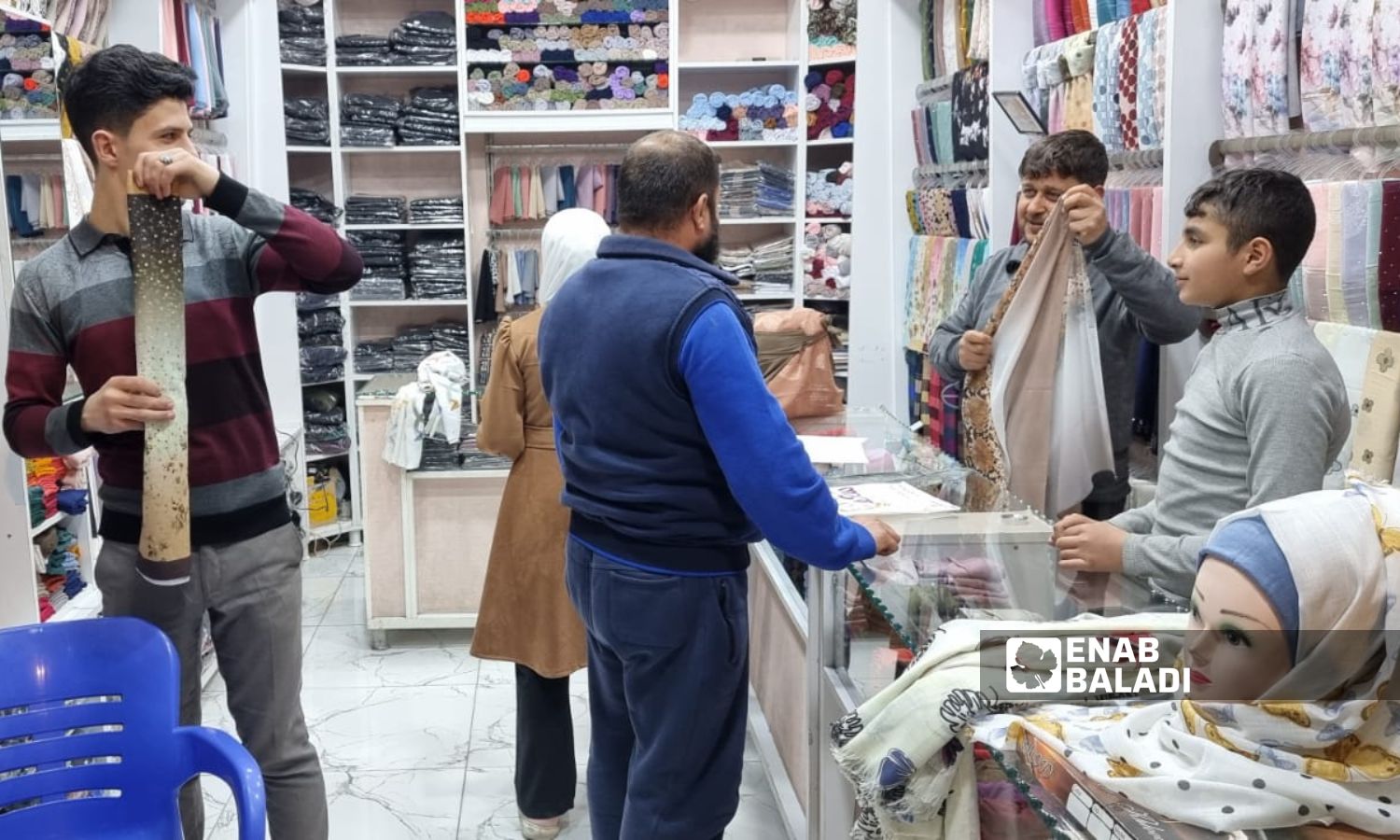



Mazen feels helpless when he looks at the prices of clothes displayed on shop fronts in the markets of Idlib, and he is distressed by his inability to buy Eid clothes for his three children.
Mazen Qanat (36 years old), who was displaced from the countryside of Homs, said that the minimum cost of clothing for one child is 35 US dollars, or 100 dollars for his three children, which is high compared to income. He works in a restaurant and his monthly salary is 150 dollars, noting that last Eid he bought clothes for them worth 75 dollars.
He added to Enab Baladi that the purchase options in the market are almost impossible because the prices of medium-quality clothes are high compared to income. As for slightly cheaper clothing, it is of lower quality and can only be worn a few times.
The young man pointed out that he is still puzzled about buying clothes for the children and may wait to get a cheaper price through offers and discounts, with a week remaining until Eid al-Fitr.
For her part, Fatima Othman, a displaced woman living in the city of Idlib, said that “Half a loaf is better than no bread” and mentioned that she bought only one piece for each of her four children (pants or sweater) so that they would not be deprived of the joy of Eid.
The woman added that the price of each piece ranged from 7 to 8 dollars, and she got them from offers and discounts, despite her conviction of the poor quality of these pieces.
Clothing prices have seen an increase, narrowing the purchasing options for families amidst deteriorating economic and living conditions, and the daily wage does not exceed 100 Turkish lira at best (three dollars), while the recognized poverty line is valued at 10,843 Turkish lira, and the extreme poverty line at 8,933 lira.
Before Eid, clothing merchants in Idlib city feared the risk of unsold goods and declining sales and market disruptions, forcing them to reduce the quantities of imported goods and change their types from mid-quality to below.
Idlib markets witness congestion; it increases after Iftar and Tarawih prayers but does not reflect the turnout for purchasing, which remains low according to sellers met by Enab Baladi.
Mohammed al-Ali, a clothing seller in Idlib, said to Enab Baladi, that citizens roam the markets as usual during these days, but sales have dropped by 50% compared to 2023.
He added that the rise in the exchange rate of the Turkish lira against the dollar and the decline in the citizens’ purchasing power are reasons for the drop in sales, pointing out that today customers only care about cheap prices, and no one asks about the quality of the piece or the type of fabric, knowing in advance that pieces on sale are of low quality.
The exchange rate of the Turkish lira against one US dollar was 31.8 for selling and 32.4 for buying, according to the Exchange Dealers Union pricing in Idlib, adopted in the region.
Many traders, including Mohammed, are compelled to conduct offers to liquidate their goods to avoid them spoiling. He now offers a “boys’ set” (pants and sweater) of medium quality for 25 dollars, a “girls’ set” for 30 dollars, and sells one set for 15 dollars but of lower quality and older models.
Another clothing trader in Idlib city, Imad al-Saghir, said that his shop’s sales have dropped 75% compared to 2023, explaining that in these days he was accustomed to selling goods worth 20 thousand dollars, but today the sales volume has not reached a quarter of the mentioned amount.
He added that offers or discounts are what attract some customers, pointing out that they come at the expense of quality, or are driven by the seller’s desire to avoid spoilage of their merchandise if it is extensive or old.
This year, Eid al-Fitr comes amid an exhausted Syrian reality, with high rates of poverty, unemployment, and need across all regions of Syria. Approximately 16.7 million people require humanitarian assistance, an increase of 9% from 2023, according to estimates by the United Nations High Commissioner for Refugees (UNHCR).
In 2024, 80% of the Syrian population will need some form of humanitarian aid, according to the 2024 Humanitarian Needs Overview (HNO).
About 55% of the population in Syria, or 12.9 million people, are suffering from food insecurity, of which 3.1 million are severely food insecure.
if you think the article contain wrong information or you have additional details Send Correction